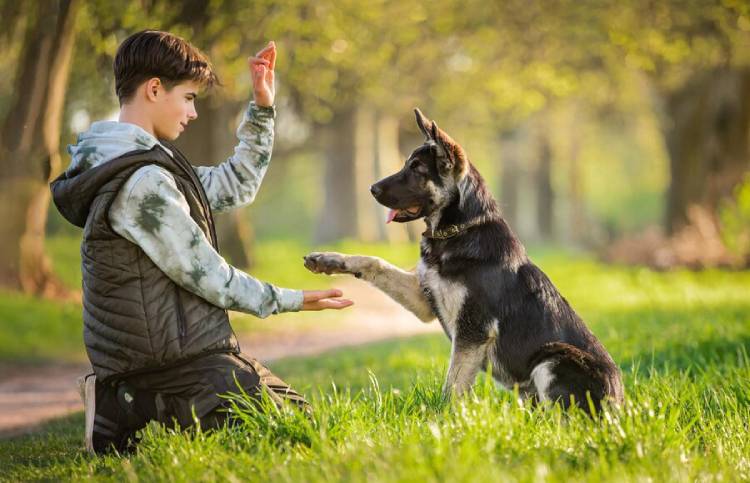When you open your home to friends and visitors, the welcoming committee often includes your tail-wagging companion. But instead of a polite greeting, many dog owners find themselves managing a whirlwind of jumping, barking, and sometimes even nipping. It’s a familiar chaotic dance that plays out in many households, but it’s not just about avoiding spilled drinks or awkward apologies.
Teaching your dog to behave around guests is crucial for everyone’s comfort and safety, including your pet’s.
Must Read: Leaving a Blind Dog Alone
Understanding Canine Behavior
Understanding why your dog acts out around strangers requires delving into the canine psyche. Dogs are pack animals by nature, and their social structures revolve around clearly defined territories and hierarchies. It’s important to know too, that certain breeds, such as German Shepherds, Bulldogs, and Chow Chows, have a tendency to be less friendly around strangers.
When a stranger enters their space, their instinctive responses can range from protective aggression to fearful anxiety. Recognizing these impulses is the first step in helping your dog learn to curb them.
Preparation is Key
Preparation for guest arrivals can make a significant difference in how your dog reacts. Ensuring your pet has had plenty of exercise beforehand can greatly reduce their energy level and potential for hyperactivity.
Creating a dedicated quiet space, equipped with familiar comforts like toys and a bed, allows your dog a safe retreat. For some pets, especially those prone to anxiety, calming aids such as pheromone diffusers or gentle music can also be beneficial.
Training Techniques
Developing a well-mannered dog around houseguests isn’t just about teaching tricks; it’s about building a behavioral blueprint that will guide your dog in various social situations. The foundation of this blueprint is grounded in basic training commands, which when mastered, can greatly influence your dog’s ability to cope with the excitement of visitors.
The command ‘sit’ is a fundamental tool. It serves as a starting point for teaching self-control. Training your dog to sit before they receive anything they want, such as food, toys, or attention, instills patience and politeness. Once your dog reliably sits on command, you can use this behavior to prevent jumping on guests as they arrive.
‘Stay’ builds on the ‘sit’ command, teaching your dog that they need to remain in a specific spot until released. This can be particularly useful when you need to open the door for guests and want to ensure your dog doesn’t dash out or overwhelm them as soon as they step inside.
Training your dog to ‘go to your bed’ gives them a clear alternative to crowding or jumping on visitors. By associating their bed with positive experiences like treats and praise, your dog learns to view it as a safe haven and a place to calm down when the environment gets too stimulating.
The ‘quiet’ command is essential for curbing barking. It’s important to understand that barking is a natural way for dogs to express excitement or alertness. Teaching your dog ‘ quiet’ begins with acknowledging your dog’s barking with a calm voice and a consistent verbal cue, followed by a reward when they cease barking.
Things to Remember:
- Consistency is key in training. Every member of the household must use the same commands and rewards to avoid confusing your pet. Training sessions should be short, positive, and frequent. Dogs learn best when training is a fun and rewarding experience.
- Positive reinforcement is the most effective and humane training method. This means rewarding behaviors you want to encourage immediately after they occur. Rewards can be treats, praise, petting, or playtime. The timing of the reward is crucial – it should be given within seconds of the desired behavior.
- In addition to these commands, it’s beneficial to simulate the scenario of guests arriving. Practice with friends or family members acting as visitors, so your dog can become accustomed to the routine. This practice helps desensitize your dog to the doorbell or a knock and allows them to associate guests with calm behavior and positive outcomes.
Remember, training is not a one-time event but an ongoing process. As your dog becomes more comfortable with each command, gradually introduce distractions to ensure their behavior remains consistent regardless of the environment. With time and patience, these training techniques will help your dog understand the expectations and behave appropriately around houseguests.
Fostering Positive Guest Interactions
How your guests interact with your dog also plays a pivotal role. Visitors should be informed in advance how to greet their dog properly, avoiding high-pitched excitement that can rile up your pet.
Encourage them to allow the dog to approach them in their own time and to reward calm behavior with gentle attention or treats.
When Things Don’t Go As Planned
However, even the best-laid plans can go awry. If your dog becomes overly excited or stressed despite your efforts, it’s important to have a strategy for gently removing them from the situation. This could mean leading them to their quiet space or even considering a short time-out in a crate if they’ve been crate-trained in a positive way.
Conclusion
Training your dog to behave around guests is a testament to patience and persistence. It’s a gradual process that requires understanding, preparation, and consistent reinforcement. By investing the time to train your dog, you’re not only ensuring the well-being of your guests and pet, you’re also paving the way for more enjoyable and stress-free social gatherings in your home.
Start today, and look forward to the day when your dog is as much a part of your warm welcome as you are.
